![]()
![]()
![]()
Use LEFT and RIGHT arrow keys to navigate between flashcards;
Use UP and DOWN arrow keys to flip the card;
H to show hint;
A reads text to speech;
115 Cards in this Set
- Front
- Back
- 3rd side (hint)
|
Define syntax |
Form. Grammar rules for putting sentences together. Sentence structure, grammar, morphology, phonology and phonetics.
|
|
|
|
Define semantics
|
Content. Vocabulary and understanding. The meaning attached to words.
|
|
|
|
Define pragmatics
|
Use. Social language, understanding emotion, understanding intentions, using language appropriately and social context
|
|
|
|
Define and give an example of a morpheme
|
This is the meaningful unit of language. In the word dogs there are two morphemes one is dog and the other is Plural /s/.
|
|
|
|
Define and give an example of a phoneme
|
These are the minimal units of sound elements. They are combined together to make morphemes (or meaningful units). They are exact sounds (like /k/ and /d/). They convey and contrast meaning.
|
|
|
|
Define and give an example of an allophone
|
This is a more numerous set of distinct sounds that represent single phonemes. The variations of phonemic sounds are dependent on the influencing sounds around them. For example: aspirated /k/ in kit and unaspirated /k/ in skit
|
|
|
|
Define and give examples of syllable shapes in the English language
|
All English sounds include one vowel sound. English has the following shapes: VC-on, CV-do, CCV-blue, CVC-dog, CCVC-truck, CVCC-test, CCCVCC-screams
|
|
|
|
Define suprasegmental
|
Elements other than consonantal and vocalic components (larger units than syllables, words, phrases, sentences). Like stress, loudness, rate, juncture, pitch and intonation.
|
|
|
|
Define prosodic features
|
Properties of speech a domain larger than a single segment (intonation, stress, rhythm).
|
|
|
|
Define distinctive features
|
These are ways we describe place manner and voice of sounds. Examples: consonantal, vocalic, sonorant, interrupted, strident, low, back, coronal, rounded, distributed, lateral, nasal, voiced
|
|
|
|
Define coarticulation
|
This is the influence of sounds on each other - influence on sounds from preceding or following sound. It makes it impossible to divide the speech stream into neat segments that correspond to phonemes. For example: sneezed- unrounded /s/ and /n/ but in snoozed- rounded /s/ and /n/
|
|
|
|
Name the front vowels
|
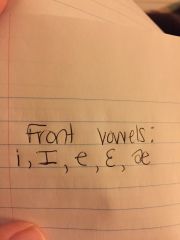
|
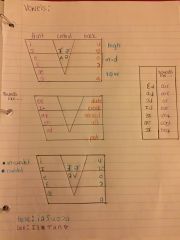
|
|
|
What are the central vowels
|
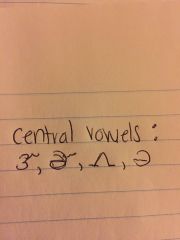
|
|
|
|
What are the back vowels
|

|
|
|
|
What are the high vowels
|

|
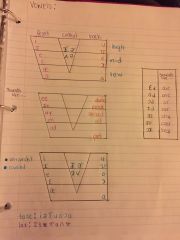
|
|
|
What are the mid vowels
|

|
|
|
|
What are the low vowels
|

|
|
|
|
What are the unrounded vowels
|

|
|
|
|
What are the rounded vowels
|

|
|
|
|
What are the tense vowels
|

|
|
|
|
What are the lax vowels
|

|
|
|
|
Here's a vowel chart you should know
|
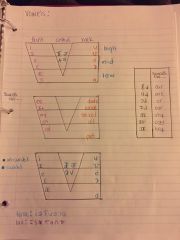
|
|
|
|
Name the stops
|
p b t d k g
|
|
|
|
Name the fricatives
|
f v th th s z sh sh
|
|
|
|
Name the affricates
|
Ch and ja
|
|
|
|
What are the obstruents
|
Stops, fricatives, affricates
|
|
|
|
Name the nasals
|
M n ing
|
|
|
|
Name the liquid laterals
|
L
|
|
|
|
Name the glides
|
R w j h
|
|
|
|
What are the sonorants
|
Nasals, liquids, and glides
|
|
|
|
Bilabials
|
p b m w
|
|
|
|
Labiodental
|
f v
|
|
|
|
Lingual alveolar
|
t d s z n l
|
|
|
|
Lingua palato alveolar
|
Sh sh ch ja
|
|
|
|
Lingua-velor |
k g ing
|
|
|
|
Glottal
|
H
|
|
|
|
Consonant chart
|
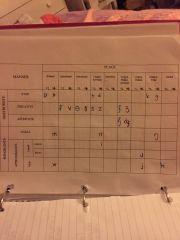
|
|
|
|
Define the three major research methods employed to examine speech acquisition
|
Diary studies, large cross sectional, longitudinal studies
|
|
|
|
Define diary studies in the advantages and disadvantages
|
Diary studies are diaries written by moms and dads (mostly linguists) that keep a detailed journal of their child's speech development and acquisition.
Advantages – these are some of the most detailed reports of language acquisition, speech is a natural Contexts, and it's a good sample a spontaneous speech. Disadvantages – you're not positive if the kid you're observing is typically developing, there's a potential for bias, and there's pressure on kids development from parents, there are some lack of structure. |
|
|
|
Define large group cross-sectional studies in the in the advantages and disadvantages
|
In this study a different group of children is tested at each age level using the same mythology. Where kids can produce sounds with 75% accuracy in all positions of words are determined. What happens on average. Imitation in single words.
advantages – typical patterns can be observed through large groups, standard mythology for all children is used. Disadvantages –Utilizes single words in imitation compared to spontaneous speech, sample collections may be limited to geographical area, atypical kids are often not included. |
|
|
|
Define longitudinal studies
|
A small group of children is followed overtime. These kids are observed on the same schedule and tested with the same procedures and by trained examiners. Typically a group of sounds or processes is studied.
|
|
|
|
What are the advantages to a longitudinal study
|
Individual differences in learning style can be captured, development sequences can be described
|
|
|
|
What are the disadvantages to a longitudinal study
|
Small group size means the children may not be representative of larger population, fix testing schedule may not allow to capture changes that occur rapidly
|
|
|
|
How do speech production and speech perception change over the course of the first 12 months?
|
Infants move from producing reflexive & vegetative sounds to sequencing of syllables (or babbling) by 6 to 10 months. The sequence goes: reflexive, cooing, laughter, vocal play, early babbling, reduplicated babbling, non-reduplicative babbling, jargon, first words. At the end of the first year infants produced diverse sounds in several syllable shapes. Babies with hearing loss or late talkers have less diverse, less frequent and delayed babbling. First words often contain front sounds that were frequent and babble. These words resemble adult words and are for meaning and produced in the same content.
Infants preferred to listen to speech sounds (specially mom) over nonspeech sounds and look at humans faces rather than objects. Infants perceive contrast between speech sounds including differences in voicing and in place. Buy one year the ability to perceive sounds weekends of foreign language. Babies are aware and can perceive language contrast very early on and in the womb. |
|
|
|
What are the early eight sounds?
|
m b j n w d p h
|
|
|
|
What are the middle 8 sounds?
|
t ing k g f v ch ja |
|
|
|
What are the late 8 sounds?
|
Sh sh th th r l s z
|
|
|
|
What are phonological patterns or processes?
|
Processes done by babies to make adult speech easier to achieve. As more sounds and mastered less processes are used. Most common are cluster reduction and liquid deviation.
|
|
|
|
Identify common phonological processes
|
Assimilation, velar fronting, gliding, stopping, depalatalization, deaffrication, final consonant deletion, cluster reduction, weak syllable deletion |
|
|
|
Define assimilation
|
A sound in a word changes to become more like another sound in the word. Can affect place manner voice thing. For example mom for mop, cook for took, top for toss.
|
|
|
|
Define fronting
|
Replacing velar back sound for front sounds. For example pay for hat, doat for goat, rin for ring
|
|
|
|
Gliding
|
Substituting liquids for glides l and r for w and y. For example wed for red, yam for lamb
|
|
|
|
Stopping
|
Substitution of stops for fricatives and affricates. For example pish for fish, dis for this, toap for soap
|
|
|
|
Depalatization
|
Subsitute of alveolar fricatives or affricates for a palatal affricate. Seck for check, dudez for judges
|
|
|
|
Final consonant deletion
|
Omission of final consonants: ha for hat
|
|
|
|
Cluster reduction
|
Substitution or deletion of all or parts of clusters. For example pay for play, top for stop, ack for black, gween for green
|
|
|
|
Weak syllable deletion
|
Deleting unstressed syllable for example: mato for tomato, nana for banana, getti for spaghetti
|
|
|
|
What processes do not persist after 3
|
Finial consonant deletion, velar fronting, assimilation
|
|
|
|
What processes do persist after 3 |
Deaf friction, weak syllable deletion, cluster reduction,stopping, depalatalization, gliding
|
|
|
|
Name the theoretical models (7)
|
Traditional, generative phon, natural phon, nonlinear phonology, optimal theory, sonority theory, psycholinguistic
|
|
|
|
Explain the traditional-behavorist theory |
watson, skinner, provolone
operant/instrumental conditioning - observable behaviors can be changed by manipulating their consequences. there can be positive reinforcers or negative punishment consequences. |
|
|
|
explain generative phonology
|
speakers have 2 types of representations
-underlying abstract representations (how they think of/classify sounds) -surface representations (how they produce sounds can be linked to phonological rules not sure if phonological rules are just convenient ways of describing what speakers do or if speakers actually apply those rules while producing speech |
|
|
|
explain linguistic natural phonology
|
phonological processes used by kids to make adult language easier ... but its seesm counter productive to describe development as unlearning something known rather than learning something new. kids have natural rules they use and then they progress or repalce what they know.
|
|
|
|
explain linguistic nonlinear phonology |
-describes ways which higher level linguistic units influence production of speech sounds
-children learn to produce speech sounds and intergrate them into higher level linguistic units (new sounds in well known syllable shapes and new syllable shapes with well known sounds) |
|
|
|
explain linguistic- optimality theory |
-children try to match the sounds they hear (input) in their production (output)
-since they cant do it perfectly, they use marked and faithful constrants (kids try to delete most marked (difficult) sounds before an unmarked sound |
|
|
|
explain linguistic- sonority hypothesis |
-sonorance scale - general loudness of sound
-kids drop sounds if not loudest consonants
cluster reduction: in initial least sonorist sound preserved like top for stop, in final most sonorist sound is preserved
vowels are louder than consonants |
|
|
|
explain psycholinguistic models |
describes preceptual/cognitive process, linguistics describes language structure
so psycholinguistics is the attempts to look at how language is processed (what is actually happening when language is learned)
input-black box-out put
black box is comprehension that we dont really understand how it works |
|
|
|
how do structual variatons in the lips affect speech |
lips can be cleft but ifs its fixed early is probably dont affect speech much |
|
|
|
structural variations and tongue |
can be too big or too small of the oral cavity
parts can be removed
speech can be compensated and fricatives and plosives are more affected |
|
|
|
structural variations and hard palate |
could be cleft or removed from cancers
speech sounds not too affected |
|
|
|
structural variations and soft palate |
can be cleft and result in nasal |
|
|
|
structural variations and nasopharynx |
tonsils.. may help compensate for incompent velem.. if too big can cause hypernasality |
|
|
|
how can downs affect speech sound productions |
delayed developmental sounds with idosyncratic errors
speech sound difficulties because: overall delay in cognitive impairment, relative reduced intelligibility, reduced muscle tone, frequent ear infections, nasaly, nasal consonants deletions
|
|
|
|
how can hearing loss affect speech sound productions |
intact hearing is essential for speech preception and self monorting in speech production. this is a physical barried to language learning and sound learning.
speech perception and production is dependant on age: ageof onset, age of implants, degree of hearing loss, provision of therapy
results in reduced intelligability, segmental errors, supasegmental errors |
|
|
|
what are neurpmotor disorders |
impairments of speech muscle control
in adults its usually a result of a stroke and other types of brain injuries
children usually caused by CP |
|
|
|
what is the difference between dysarthria and apraxia |
dysarthria is paralysis, weakness, incoordication caused by nervous system damage due to lesions, trauma, or disease
apraxia - difficulty programming speech movements (motor speech) problems in the comprehension turining into output stage |
|
|
|
what is comorbidity? |
when two or more disorders exsist at the same time. this is imporant for:
-identifying the nature of the problem, understanding the relationship of 2 disorders, and implications for intervention |
|
|
|
what are soeech sound disorders likely to cooccur with? |
language disorders, stuttering, voice disorders, emotional/psychiatric disorders |
|
|
|
why does SSD come with language disorders? |
both involved aspects of the language system (form, content, use) |
|
|
|
why do SSD come with stuttering? |
both more common with genetic disorders.. both involve speech producton and deal with motor and language compodents |
|
|
|
why do SSD come with voice disorders |
reducded intelligability may lead to voice disorders due to effort trying to produce speech |
|
|
|
why do SSDs come with emotional/psychiatric disorders? |
reduced intelligibility leads to frustration and anexity |
|
|
|
how is hearing loss related to SSD |
physical barrier to hearing and precieveing/producing speech sounds - cant hear to discriminate |
|
|
|
how is speech perception related to SSD |
the ability to discriminate sounds is speech perception. if you precieve sounds incorrectly, youll produce them incorrectly... you can have problems precieving input or output |
|
|
|
how is gross & oral facial motor skills related to SSD |
oral facial - sensory feedback from articulators (feelings of the sounds.. dont really notice them)
gross motor - unrelated to SSD because theyre more sensory to feedback.. early 8 sounds are gross motor.. easier to produce |
|
|
|
how are intelligence realted to SSD |
theres a correlation between intelligence and articulation
low intelligence is associated with more SSD
language development problems = trouble with word length, syntactic complexity (top down) syntactic accuracy is affected by word length and phonological complexity (bottom up) |
|
|
|
how is academic preformance related to SSD |
if you have a SSD you probs have poor reading/spelling skills
dyslexia - normal speech artic but weak phonological awareness skills |
|
|
|
how is age related to SSD |
by 8 all artic and phonological skills should be good to go
artic decreases grade to grade starting at 1st ending in 5/6 |
|
|
|
how is gender related to SSD |
boys more likely to have speech sound disorders than girls
but differences are small and dissapear after age 5 |
|
|
|
how is SES realted to SSD |
measures by parents EDU & jobs
seems to have no relation or be a secondary aspect |
|
|
|
how is family tendicies related to SSD |
genetics and environment you grow up in |
|
|
|
what is the difference between a speech sound screening and a comprehensive speech sound assessment battery? |
screening is a breif tool that screens for reg flags. for speech they either read a passage or a few sentences with a variety of sounds in them
a assessment tests all phonetic contexts, linguistic units, eliciation contenxts (pic naming, imitation, convo) |
|
|
|
what is citation citing? |
elecitation procedures: spontaneous picture naming v. imitation
stimuli: pictures, colored pictures, line trawings or toys |
|
|
|
what are the advantages of citation citing |
-you know what the target is -control over what sounds youll hear -efficient -easy to transcribe |
|
|
|
what are the disavantages of citation citing |
-not natural -few tokens of each sound -hard to evaluate consistency -may be affected by feature words (familiartiy, length) |
|
|
|
what are the advantages of spontaneous speech samples |
-can test conversational speech in natural environment -how consistently kiddo produces sounds -multiple sounds across different words -consistency of mistakes can be evaluated -can see the overall severity -can be good for kiddos who cant standarize test |
|
|
|
what are the disadvantanges of spontaneous speech samples |
-time consuming -sometimes clients are very unintelligiable -some sounds might not occur -sometimes kiddos avoid certain sounsd |
|
|
|
What is stimubility testing and what are the goals of it |
preformed for erred sounds
first produce sound in isolation then in nonsence syllables in pre inner and post with different vowels then in real words
uses: determines needs for intervention intervention goal setting at what level intervention should start |
|
|
|
what is contextual testing and its goals? |
-examining articulation of and error sound in the context of different neighboring sounds
-assumption-some sound may help say other sounds
-goal-fora child who roduces a sound inconsistently yo determine what contexts are the more facilitative
|
|
|
|
what is pattern analysis and what are its advantages |
this is when you look for patterns that go wrong in either place manner and voicing or in phonologcal processes
this will make it easier to pick targets and goals and objectives for therapy
this will speed things up in therapy |
|
|
|
what is intelligibility and how is it measured? |
a scale of how intelligble or intelligable you are from you cant understand the kiddo or hes very clear and precise.
measured: -open set word identification-% of words identified in speech sample -closed set word identifcation- % of words read or repeated from a list of words that can be identified by the speaker -rating scales |
|
|
|
what is severity and how is it measured? |
degree of impairment (mild, moderate, sever) based on clinician judgement
measured- -PCC & consonants correct -incorrect consonants (deletions, subsitutions, distortions, additions etc) -dialectal |
|
|
|
What are some of the reasons why large scale normative studies of the age of acquisition provide inconsistent data?
|
-methodological constraints
-sing words, not convos -one word for each speech sound in each word position -samples not fully representative of typical speaking situations -variability in production has not been considered |
|
|
|
Describe three approaches to classification of speech sound disorders of unknown origin
|
Causes- etiology - searching for what originally caused the problem, which may have led to other problems, that may now be maintaining the disorder. Psycholinguistic deficit - focuses on the difficulty the child may be having processing speech in the brain. And symptomatology- symptoms provide the best perspective on classification
|
|
|
|
What are some of the constraints on the sounds used during the transition from words to speech (first50)?
|
3 types of constraints:
-inventory constraints: inventory of sounds that are produced by the child -positional constraints: sounds produced in different syllable shapes -sequence constraints: restrictions on the co-occurrence of sounds First words often contain front sounds that were frequent in babble and syllable shapes. First words resemble adult words and are for meaning and used in the same context. |
|
|
|
What assessment procedures may accompany the administration of a comprehensive speech sound battery? What is their purpose?
|
-oral cavity examination: checking speech mech for issues
-audiological screening: determine whether a client exhibits a moss or reduction of auditory function which could be etiological factor associated with the phonological disorder -speech sound perception/discrimination testing: covers a wide variety of sound constraints, became a standard procedure in the assessment battery -does not examine constraints relevant to a particular child's error production samples a wide variety of contrast (golden fristoe) |
|
|
|
/eI/
|
Ay, hey
|
|
|
|
/aI/
|
Bye my type life
|
|
|
|
/aI/
|
Bye my type life
|
|
|
|
/cI/
|
Oy, boy now how mouth owl
|
|
|
|
/aI/
|
Bye my type life
|
|
|
|
/cI/
|
Oy, boy now how mouth owl
|
|
|
|
/ou/
|
Hope flow snow
|
|
|
|
/cI/
|
Oy, boy soy
|
|
|
|
/au/
|
Cow now mouth how owl
|
|

